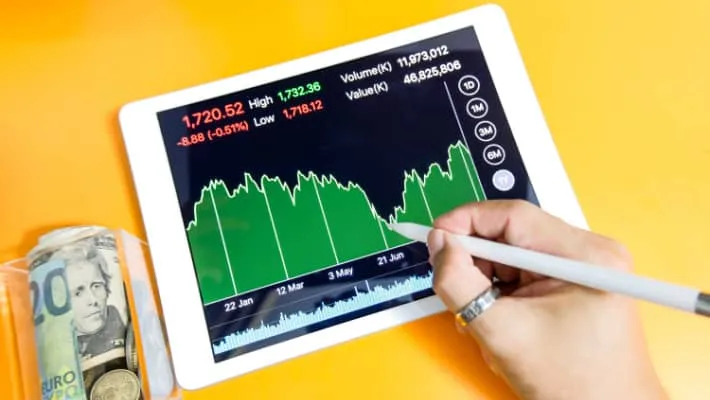Wednesday Nov 22 2023 11:10

11 min

The financial market features a wide array of indices, with currency indices being among the most prominent. For those who are new to trading, particularly in indices trading, this article is prepared to provide insights into the basics of currency indices.
Let's begin decoding currency indices, which hold substantial potential for becoming a lucrative financial opportunity for your portfolio.
Currency indices measure the strength or weakness of a particular currency relative to a basket of other currencies. These are widely used by traders, investors, and central banks to monitor currency movements and make informed trading decisions as they provide a broader perspective on the overall performance of a currency.
Currency indices are formed using a weighted average formula, where each currency in the basket is assigned a specific weight. The weights are based on trade volume, Gross Domestic Product (GDP), and other economic indicators. The computation of a currency trade index involves constant monitoring and periodic adjustments to reflect changes in the global economy and currency markets.
You should also check out this article: Understanding major pairs in forex: Things you need to know (with examples)
The difference between a single-currency and a multi-currency index lies in the number of currencies included in each index and the purpose for which they are used.

As the name suggests, a single currency index is composed of only one currency. It is a measurement tool that reflects the strength or weakness of a specific currency relative to a basket of other currencies.
For example, the US Dollar Index (USDX) measures the value of the US dollar against a basket of six major currencies, including the euro, Japanese yen, British pound, Canadian dollar, Swedish krona, and Swiss franc. It provides a snapshot of the overall performance of the US dollar in the foreign exchange market.
On the other hand, a multi-currency index is composed of multiple currencies. It is a broader measurement tool that takes into account the performance of several currencies simultaneously. The purpose of a multi-currency index is typically to provide a benchmark for the overall strength or weakness of a group of currencies.
For instance, the Trade-Weighted Index (TWI) is used by central banks to assess the value of their domestic currency against a basket of currencies of their major trading partners. It helps policymakers monitor the competitiveness of their country's exports and imports.
Here are some ways you can use currency indices in your trading:
Check out this article: What are CFDs in forex and how do they differ from forex trading?

Currency indices can provide a potential avenue for diversification and exposure to foreign markets. However, knowing the risks associated with this type of asset is important. Here are some key risks to consider:
Diversification and thorough research can help mitigate some of these risks. Still, it is necessary to stay informed and monitor market conditions continuously. Consulting with a financial advisor or your broker can also provide valuable guidance in navigating the complexities of currency index for beginner traders.
A renowned platform, markets.com offers a comprehensive acquire knowledge about trading. This resource provides valuable insights into the fundamentals and strategies essential for achieving success in the financial markets. Whether you are a beginner or a seasoned trader, the platform equips you with the necessary tools and information to enhance your trading skills and seize opportunities in the market.
One popular approach for trading currency indices is to follow trends. This strategy involves identifying and trading in the direction of the prevailing trend. To identify potential opportunities, you can use technical analysis tools such as moving averages, trendlines, or chart patterns.
Another strategy suitable for trading currency indices is range trading. This approach involves identifying significant support and resistance levels within a specific price range. Traders can buy near support and sell near resistance, taking advantage of price oscillations within the range. Utilising indicators like Bollinger Bands or oscillators such as the Relative Strength Index (RSI) can aid traders in identifying overbought or oversold conditions, further enhancing their range trading strategy.
A breakout strategy focuses on identifying currency indices experiencing a significant price breakout from a range or consolidation pattern. Traders can set entry orders above the breakout level to capture potential upside momentum.
Waiting for confirmation of the breakout through increased volume or other technical indicators is essential before entering a trade. This strategy can be particularly effective when combined with proper risk management techniques, such as setting stop-loss orders to protect against potential reversals.
In addition to technical analysis, traders can utilise fundamental analysis when trading currency indices. This involves analysing economic data, geopolitical events, and monetary policy decisions that can impact currency values. You can make more informed trading decisions and anticipate potential market movements by staying notified about these factors.
Diversification is essential for trading currency indices, as it helps spread risk across different currencies. By trading multiple currency indices, you can reduce their exposure to any single currency and mitigate potential losses. Additionally, diversification allows you to take advantage of different currency pairs' market conditions and opportunities.
Currency indices measure the strength or weakness of a particular currency compared to a basket of other currencies. You can use this financial asset to identify trends, gauge market sentiment, diversify portfolios, monitor economic indicators, and manage risk.
However, risks are associated with trading currency indices, such as currency volatility, economic and political risks, liquidity risk, counterparty risk, and market risk. You can utilise trading strategies such as trend-following, range trading, breakout trading, fundamental analysis, and diversification to combat the challenges of trading indices.
If you are confident and knowledgeable about trading on currency indices, you can trade it through a contract for difference (CFD). In this type of trading, you will be speculating the price of your chosen indices without having an actual asset.
One of the best platforms worldwide, markets.com offers 30 popular CFD indices that professionals and beginner traders frequently trade.
Discover the benefits of markets.com and start trading in CFD currency indices today.
Check out this article: What are CFDs in forex and how do they differ from forex trading?
When considering "CFD currency indices" for trading and price predictions, remember that trading CFDs involves a significant degree of risk and could result in capital loss. Past performance is not indicative of any future results. This information is provided for informative purposes only and should not be construed to be investment advice."